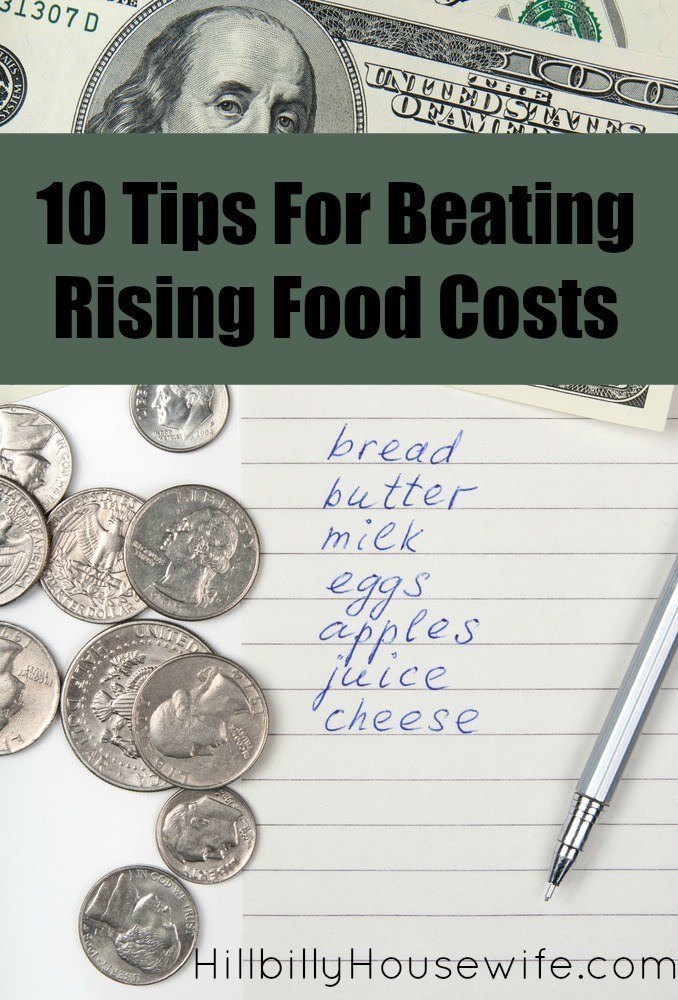10 Tips For Beating Rising Food Costs
Grocery prices have been going up and up over the past few years and there is no end in sight. I don’t know about you, but we’re spending a much bigger chunk of our budget on food these days. That means I’m making every penny count and doing my best to make smart purchases.
Today I thought I’d share my 10 best tips for beating the rising cost of food. I hope you’ll find it helpful. Scroll down for all 10 Tips

Tip #1 – Go Meatless
This is the one you probably hear about most when it comes to cutting back on grocery spending. It’s sad but true… meat prices have skyrocketed. It’s also one of the easiest ways to cut back on food.
I’m not saying skip meat all-together if you don’t want to. But do try a couple of different things:
- Pick a few days a week were you make meatless meals. Try pasta and veggies, egg dishes, beans and rice etc.
- Use meat as a side or a condiment instead of the main part of the meal. You can make delicious pasta sauce with just a little ground beef or sausage. If you’re serving chicken, or pork chops and the likes, add a bunch of sides so you can get away with small portions of meat and still have a filling meal.
- If you do use meat, look for whatever is on sale and stretch it as far as you can. I like getting a whole chicken on sale, cook it in the slow cooker and then use the meat for lunches and dinners throughout the week.
- Don’t forget about breakfast meats for dinner. A little bacon or sausage goes a long way with all that yummy flavor.
Tip #2 – Whip Up A Frugal Meal
We all have family meals that are particularly frugal. If you can’t think of them right away, ask around. I’m sure your aunt, grandma or cousin will remember something delicious that used to be whipped up when there wasn’t much to go around. I remember growing up eating things like scalloped potatoes with little bits of ham (if we had it), cream and some cheese for dinner. My husband’s family would fix scrambled eggs or a big pot of grits.
Then of course there are all the things we now typically think of as frugal meals. Beans and rice come to mind. Get creative and come up with a list of your top 5 frugal meals and make at least one a week. Cornbread and pinto beans are another frugal favorite around here.
Tip #3 – Don’t Waste It – Using Up Leftovers
Nothing hurts your grocery budget more than throwing away food that’s going to waste before you can eat it. Plan your meals to eliminate most food waste, then make sure you use up every little bit. Think outside the box to figure out how you can turn even small amounts of leftovers into new meals.
A couple of weeks ago we had chili. We ate chili for lunch and dinner and at the end of the night there was one decent sized bowl of chili left. It would have been enough to feed one of us for dinner. Instead I fixed 3 large baked potatoes, cut them up, put butter on them and then topped them with the re-heated chili and some shredded cheese. It ended up being a large dinner for all 3 of us and didn’t cost much at all.
In addition to potatoes, I like to keep large flour tortillas and rice on hand. With that and some leftover veggies and meat you can make a never ending variety of burritos. The leftovers basically just add some flavor to the tortilla and rice.
Tip #4 – Soups Are Good For The Wallet
There’s a reason Mom would often put on a big pot of soup or stew. They are the perfect way to use up whatever is left in the fridge and they are cheap too. This is particularly true if you save the bones from the chicken you roast on Sunday to make homemade stock. If that’s not your thing, use water and chicken bullion cubes. It’ll still be tasty and almost as cheap. Start with the liquid and add some veggies, beans, rice or potatoes and whatever bits of meat are leftover from other meals. Or keep it a vegetable soup.
Ground beef and vegetable soup is another favorite around here. You don’t need much meat, just enough to give it some flavor, then fill your pot with plenty of canned veggies, some water and a few bullion cubes. Let everything simmer for half and hour to an hour and serve.
Tip #5 – Grow Some Food
Every little bit of food that you don’t have to buy helps the bottom line. You don’t have to have a huge garden to make growing your own food pay off. Sometime simple like growing some fresh herbs or having a living salad bowl helps. Fresh produce gets expensive and growing your own will quickly add up.
Grow a few tomato plants, maybe plant some cucumbers and see how it goes. Potatoes are also easy to grow. Or how about a couple of fruit trees? Give it a try and see if growing your own food is something you can make work for you and your family.
We are slowly starting to grow more and more. We started with just a couple of tomato plants and keep expanding. This year we started growing okra and hot peppers in the front yard. They looked beautiful all through spring and summer and we got plenty of veggies to harvest as well.
Tip #6 – Breakfast For Dinner
This is one of my favorite ways to cut back on the grocery budget for the week. Almost all breakfast foods are cheap, particularly if you make it from scratch. Toast and eggs don’t cost much. Or how about a big bowl of oatmeal or cheese grits. It’s hard to fill up for less.
Mix it up and bring back all your breakfast favorites that we just don’t have the time to fix in the morning. Bacon , pancakes, waffles, omelets… you name it and it tastes just as delicious for dinner as it does for breakfast.
A family favorite around here right now is biscuits and gravy. I make the biscuits from scratch and while they bake, I fry up a little sausage and make a nice batch of gravy. Slice up a few apples as a side dish and dinner is done.
Tip #7 – Stop The Snacks
A few years ago I started tracking what I bought and what I spent on certain types of food. My biggest surprise was how much we spent on snack foods. Not only did it hurt our wallet, it also wasn’t good for the waist line. We cut out 95% of the snacks and just don’t keep them around anymore. Everyone is fine with the main meals I fix and is actually hungry when it’s time to sit down for dinner.
If you do need to have some snacks (after the kids get back from school and are hungry for example), stick with frugal fare like homemade popcorn or apple slices. Crackers and cheese are also a popular option around here on the rare occasions when we do still snack.
Tip #8 – Skip Convenience Foods – Make It From Scratch
Speaking of making things from scratch … it will almost always save you money (and be healthier). When you buy convenience foods like canned soup, frozen meals and the likes you pay for that convenience. I challenge you to give making food from scratch a try. You’ll be surprised how much quicker and easier it is.
Make things in bulk whenever possible and store leftovers for later. You can make a big batch of soup and freeze half for another quick meal.
Here are some homemade convenience food recipes for you to try.
Tip #9 – Buy Local and Seasonal
There’s been a lot of talk about eating local in media. As a result, some local fare has gone up in price, but there are still plenty of bargains to be found. For example, you can visit a local apple orchard, pick your own apples and get enough to use throughout the year for pennies on the dollar.
Take a look at what local options are available for you and pay attention to the season we’re in. If you’re not familiar with what’s in season when, do a little research online. Do your best to stick to fruits and vegetables that are in season. Often you will find these on sale at the store. When you find a really good deal, stock up and put up food by canning it or freezing it.
Tip #10 – Shop Around – Keep A Price Book
I saved the best for last. This takes a little bit of time and effort in the beginning but it is well worth it. Do you ever go to the store and think that the item that’s on sale really doesn’t sound like that good of a deal? Or do you ever wonder if you’d be better off buying milk and eggs at the drug store? There are lots of great deals to be found, but you have to remember what’s a good deal and where you should be getting it.
That’s were a price book comes in handy. Pick up a small little notebook and a pen and toss it in your purse. The next time you go to the store, start jotting down the unit of measure and price of the most common things you buy. I like to group things by section of the store (i.e. Produce, Meat, Dairy, Bread Aisle etc. )
Take the book with you and you have a quick way to check if that sale on the gallon of milk really is a good deal, or if you should be stocking up on rice and flour. Give it a try.
I encourage you to try all the tips in this post. Not all of them will work for you and they likely won’t always work for you. The key is to pick and choose and make it work for you.
I’m certain these aren’t the only ways we can save on groceries. If you have a tip, please share it in the comments below. Thank you!
To support the blog, check out the HBHW eBooks available on Amazon. Thank you!
Disclosure: Some of the links below are affilate links, meaning, at no additional cost to you, I will earn a commission if you click through and make a purchase.

